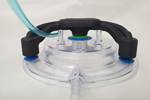One-Step Color Masterbatch Production
KraussMaffei Berstorff Liquid Color Compounding Technology allows masterbatches to be run without the need for ‘mono-concentrate’ production steps.
KraussMaffei Berstorff is showing direct production of PE color masterbatches on a ZE 28 BluePower twin-screw extruder, using what it says is a unique liquid color-compounding process to produce masterbatches of any color in a single cycle, meaning no intermediate mono-concentrate production step.
The ZE 28 BluePower running in the booth has a 46:1 L/D and is equipped with a liquid- and solids-metering system so that color masterbatches can be produced using any type of starting material. Color masterbatches are usually based on mono-concentrates, which are produced on single-screw extruders in a separate processing step, intermediately stored and then fed into the twin-screw extruder in a second step. With the liquid-color compounding technology, the intermediate mono-concentrate production step is no longer needed. Color masterbatches produced this way are said to offer “unparalleled cost-effectiveness and unique color precision.” The firm’s twin-screw extruders are self-cleaning, so changes from dark to bright colors can reportedly be made without any problems.
Recipes stored in the the company’s proprietary Process Control Advanced system are automatically set for the complete line at the simple push of a button on the control panel. The compounding line exhibited is furnished with an Econ underwater pelletizer.
The company says ZE 28 BluePower twin-screw extruder is ideally suited for research and development applications as well as for small-batch production. All extruders in the ZE BluePower series feature an OD/ID diameter ratio of 1.65, a specific torque from 13.6 up to 16 Nm/cm3 and high drive power and are rated for speeds from 900 to 1200 rpm. The 4D and 6D barrel sections that can be combined with the extensive range of modular screw elements.
Related Content
-
Twin-Screw Showcased in Circular Economy Demo
NPE2024: A KraussMaffei twin will upcycle pelletized blood vials, which will then be overmolded on another press to produce bottle openers.
-
Configuring the Twin Screw Extruder: Part 4
For many compounding operations, material is fed to the extruder at the feed throat. This is the case when feeding a single polymer or a blend of polymers mixed with solid additives. Some ingredients, however, present a challenge in feeding. Here’s how to solve to them.
-
How to Configure Your Twin-Screw Extruder: Part 3
The melting mechanism in a twin-screw extruder is quite different from that of a single screw. Design of the melting section affects how the material is melted, as well as melt temperature and quality.












